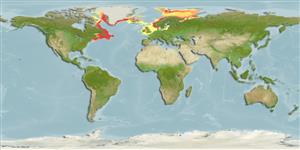Preferred temperature (Ref.
115969): 0.6 - 7.6, mean 3.5 (based on 717 cells).
Phylogenetic diversity index (Ref.
82804): PD
50 = 0.5938 [Uniqueness, from 0.5 = low to 2.0 = high].
Bayesian length-weight: a=0.00339 (0.00183 - 0.00626), b=3.19 (3.02 - 3.36), in cm Total Length, based on LWR estimates for this species & (Sub)family-body (Ref.
93245).
Trophic level (Ref.
69278): 3.8 ±0.62 se; based on food items.
Widerstandsfähigkeit (Ref.
120179): niedrig, Verdopplung der Population dauert 4,5 - 14 Jahre. (K=0.06-0.13; tm=8; Fec=4,200-35,200).
Fishing Vulnerability (Ref.
59153): Very high vulnerability (80 of 100).
Climate Vulnerability (Ref.
125649): Moderate vulnerability (43 of 100).
